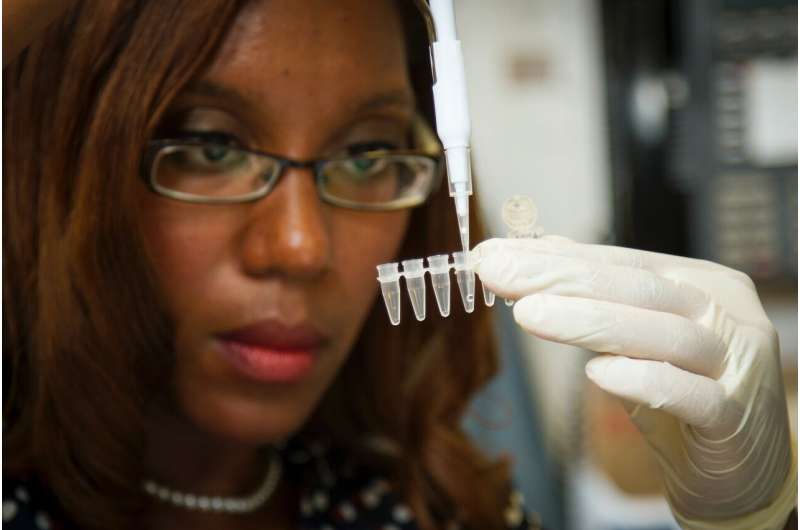 Credit: Unsplash/CC0 Public Domain
Credit: Unsplash/CC0 Public Domain
Using nanopore sequencing, a rapid third-generation cytogenetic analysis tool, investigators are now able to accurately detect specific genomic disorders in a fraction of the time it takes to conduct traditional and molecular cytogenetic testing. This facilitates earlier diagnosis of genetic disorders and accelerates appropriate clinical management for patients and their families. Their work appears in The Journal of Molecular Diagnostics.
Nanopore sequencing is a third-generation scalable sequencing technology that enables direct, real-time analysis of long DNA or RNA fragments. Among a wide range of possible applications, it has proven effective in identifying copy number variants (CNVs). CNVs are additional or missing copies of genetic material within chromosomes, and they underlie many neurological, psychiatric, and malformation disorders. Routinely, CNVs are investigated through cytogenomic techniques with significant limitations in terms of resolution and turnaround times.
"Conventional cytogenetics and chromosomal microarray analysis are still the gold standard for the detection of large and small CNVs, respectively, and second-generation sequencing, developed for different genetic alterations, has been adapted to identify CNVs," explained lead investigator Alberto Magi, Ph.D., Department of Information Engineering, University of Florence, Florence; and Institute for Biomedical Technologies, National Research Council, Segrate, Milan, Italy. "But because they are slow, expensive and often inconclusive, patients are given sequential genetic tests until the underlying genetic cause is finally identified. This can result in weeks or even months of diagnostic uncertainty. We wanted to see if a newer third-generation technology, long-read nanopore sequencing, could speed up this process."
Long-read nanopore sequencing can resolve highly homologous as well as repetitive genomic regions, improving CNV detection and mapping. Nanopore technologies are easy to use and are capable of completing a sequencing run in 24 to 48 hours. They have the additional benefit of allowing data analysis in real time, while the sequencing process is going on, which may drastically reduce detection times. This efficient diagnostic tool is suitable for widespread use in genetic laboratories.
The investigators tested DNA samples from seven patients with previously identified CNVs of different sizes and levels of mosaicism, (i.e., the CNV was not present in all the cells of the body, but in a portion of them). The samples were analyzed using long-read nanopore sequencing technology, the Nano-GLADIATOR. It was used in the online mode for real-time analysis of the reads at several time points from 30 minutes to 48 hours, and in offline mode to evaluate the resolution of complete nanopore runs for genomic alterations of different sizes. The sample-to-result times were compared with state-of-the-art array-based comparative genomic hybridization (aCGH). Researchers also evaluated sensitivity and specificity of nanopore sequencing for the identification of pathogenic small CNVs.
The study showed that diagnosis of larger chromosomal alterations could be made in one day, whereas turnaround time for smaller CNVs is estimated to be two days. This represents a consistent improvement compared to conventional diagnostic testing for CNVs, with estimated reporting times from three to15 days.
In addition, nanopore sequencing can identify mosaic CNVs with higher sensitivity than aCGH. In fact, it diagnosed a mosaic CNV in a patient sample that was not called out by the aCGH diagnostic algorithms.
"Pathogenic mosaic structural variants have been identified in approximately 0.3% to 0.77% of patients affected with developmental disorders," co-investigators Tommaso Pippucci, Ph.D., and Pamela Magini, Ph.D., U.O. Genetica Medica, IRCCS Azienda Ospedaliero-Universitaria di Bologna, Bologna, Italy, observed. "Because the sensitivity of current CNV detection methods for mosaicism is limited, the frequency may be underestimated. Moreover, mosaicism may be missed in parents of children with de novo pathogenic CNVs, leading to inaccurate guidance on recurrence risk and improper management of future pregnancies."
"In the last decades, medical genetics has been revolutionized by rapid technological innovations. Nanopore sequencing perfectly fits into this biomedical revolution, improving the detection of a class of genomic alterations that has been overlooked for technical reasons," added co-investigators Alessandra Mingrino, Ph.D., and Barbara Gega, BSc, Department of Experimental and Clinical Medicine, University of Florence, Florence, Italy. "The implementation of rapid technologies may significantly reduce technical times and greatly improve the diagnosis of genomic disorders caused by chromosomal gains or losses."
More information: Pamela Magini et al, Third-Generation Cytogenetic Analysis,
The Journal of Molecular Diagnostics (2022).
DOI: 10.1016/j.jmoldx.2022.03.013